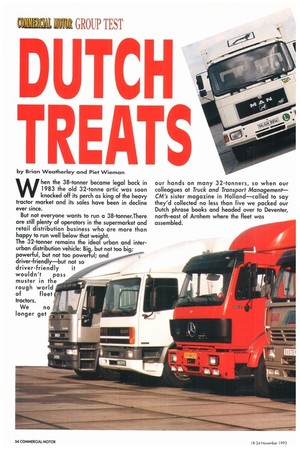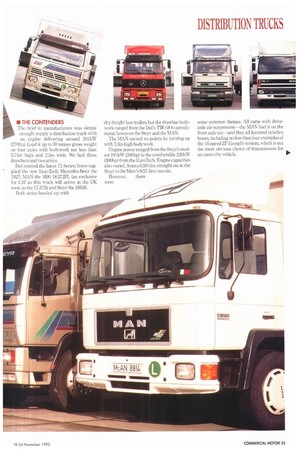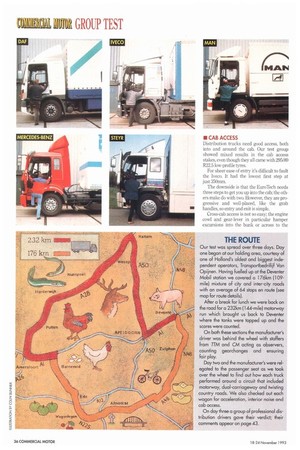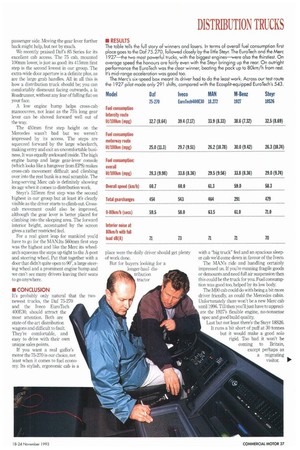DUTCH
Page 36

Page 37

Page 38

Page 39

Page 40

If you've noticed an error in this article please click here to report it so we can fix it.
TREATS by Brian Weatheriey and Piet Wieman When the 38-tonner became legal back in 1983 the old 32-tonne artic was soon knocked off its perch as king of the heavy tractor market and its sales have been in decline ever since.
But not everyone wants to run a 38-tonner.There are still plenty of operators in the supermarket and retail distribution business who are more than happy to run well below that weight. The 32-tanner remains the ideal urban and interurban distribution vehicle: Big, but not too big; powerful, but not too powerful; and __.---- driver-friendly—but not so ,- driver-friendly it wouldn't pass muster in the rough world of fleet tractors.
We no longer get our hands on many 32-tonners, so when our colleagues at Truck and Transport Management— CM'S sister magazine in Holland—called to say they'd collected no less than five we packed our Dutch phrase books and headed over to Deventer, north-east of Arnhem where the fleet was assembled. I, E THE CONTENDERS The brief to manufacturers was simple enough: supply a distribution truck with an engine delivering around 201kW (270hp). Load it up to 30 tonnes gross weight on four axles with bodywork not less than 3.75m high and 2.5m wide. We had three drawbars and two artics.
Daf entered the latest 75 Series; Iveco supplied the new EuroTech; Mercedes-Benz the 1927; MAN the M90 18272FL (an exclusive for CM as this truck will arrive in the UK soon, as the 17.272); and Steyr the 18S26.
Both artics bowled up with dry-freight box trailers but the drawbar bodywork ranged from the Dais TIR tilt to aerodynamic boxes on the Steyr and the MAN.
The MAN earned no points by turning up with 3.3m-high bodywork.
Engine power ranged from the Steyr's modest 19] kW (260hp) to the comfortable 220kW (300hp) from the EuroTech. Engine capacities also varied, from a 6.59-litre straight-six in the Steyr to the Merc's 9.57-litre vee-six.
However, there were some common themes. All came with driveaxle air suspension—the MAN had it on the front axle too—and they all featured synchro boxes, including no less than four examples of the 16-speed ZF Ecosplit system, which is not the most obvious choice of transmission for an inner-city vehicle. • CAB ACCESS Distribution trucks need good access, both into and around the cab. Our test group showed mixed results in the cab access stakes, even though they all came with 295/80 R22.5 low-profile tyres.
For sheer ease of entry it's difficult to fault the Iveco. It had the lowest first step at just 350nuri.
The downside is that the EumTech needs three steps to get you up into the cab; the others make do with two. However, they are progressive and well-placed, like the grab handles, so entry and exit is simple.
Cross-cab access is not so easy; the engine cowl and gear-lever in particular hamper excursions into the bunk or across to the passenger side. Moving the gear lever further back might help, but not by much.
We recently praised Daf's 85 Series for its excellent cab access. The 75 cab, mounted 100mm lower, is just as good: its 415mm first step is the second lowest in our group. The extra-wide door aperture is a definite plus, as are the large grab handles. All in all this is how a distribution truck should be; you can comfortably dismount facing outwards, a la Roadrunner, without any fear of falling flat on your face.
A low engine hump helps cross-cab manoeuvres, not least as the 75's long gear lever can be shoved forward well out of the way The 450min first step height on the Mercedes wasn't bad but we weren't impressed by its access. The steps are squeezed forward by the large wheelarch. making entry and exit an uncomfortable business. It was equally awkward inside. The high engine hump and large gear-lever console (which looks like a hangover from EPS) makes cross-cab movement difficult and climbing over into the rest bunk is a real scramble. The long-serving Merc cab is definitely showing its age when it comes to distribution work.
Steyr's 525mm first step was the second highest in our group but at least it's clearly visible as the driver starts to climb out. Crosscab movement could also be improved, although the gear lever is better placed for climbing into the sleeping area. The forward interior height, accentuated by the screen gives a rather restricted feel.
For a real giant leap for mankind you'd have to go for the MANIts 560mm first step was the highest and like the Mem its wheelarch squeezes the steps up tight to the A-post and steering wheel. Put that together with a door that didn't quite open to 90, a large steering wheel and a prominent engine hump and we can't see many drivers leaving their seats to go anywhere.
• CONCLUSION It's probably only natural that the two newest trucks, the Daf 75-270 and the Iveco EuroTech 400E30. should attract the most attention. Both are state-of-the-art distribution wagons and difficult to fault They're comfortable, and easy to drive with their own unique sales points.
If you want a real gaffer's motor the 75-270 is our choice, not least when it comes to fuel economy. Its stylish, ergonomic cab is a • RESULTS The table tells the full story of winners and losers. In terms of overall fuel consumption first place goes to the Daf 75.270, followed closely by the little Steyr. The EuroTech and the Mem 1927—the two most powerful trucks, with the biggest engines—were also the thirstiest. On average speed the honours are Fairly even with the Steyr bringing up the rear. On outright performance the EuroTech was the clear winner, beating the pock up to 80km/h from rest. It's mid-range acceleration was good too. The Merc's six-speed box meant its driver had to do the least work. Across our test route the 1927 pilot made only 291 shifts, compared with the Ecosplit-equipped EuroTech's 543.
place were the daily driver should get plenty of work done.
But for buyers looking for a longer-haul distribution tractor with a "big truck" feel and an spacious sleep. er cab we'd come down in favour of the Iveco. The MAN's ride and handling certainly impressed us. If you're running fragile goods or demounts and need full air suspension then this could be the truck for you. Fuel consumption was good too, helped by its low body.
The M90 cab could do with being a bit more driver friendly, as could the Mercedes cabin. Unfortunately there won't be a new Mere cab until 1996. Till then you'll just have to appreciate the 1927's flexible engine, no-nonsense spec and good build quality Last but not least there's the Steyr 18526. It runs a bit short of puff at 30 tonnes but it would make a good solo rigid. Too bad it won't be coming to Britain, except perhaps as a migrating visitor.
• DRIVERS' COMMENT Our panel of professional drivers all work for Unigro BV in Doetinchem, the regional distribution centre for Spar and Super supermarkets. The company operates a mixed fleet of Daf 2100, 2500 and 2700s with some Mercedes Benz 1927s.
Henk Pasman reckoned the steering qualities of the latest Mercedes are better than previous models, especially driving straight ahead. The 1927's low torque was "ideal" and reduces the number of gearchanges—but he didn't like the split side window. Ria Houwers liked the Steyr's built-in oil and water checks in the dashboard, "especially on cold, wet winter mornings." She was less impressed with the 18526's gear shift pattern and heavy clutch action. Henk Jolink rated the steering and directional stability of the MAN very highly. The air-sprung front axle got the thumbs up too, but the interior "is a little bit simple and the styling of the cab exterior not spectacular". Theo Meyer felt the 75-270's steering was superior, especially on asphalt motorway sections where the lane has been heavily rutted. "Interior, suspension and driver comfort: all very good." His one small criticism was that the mirror heating switch was difficult to reach. Harry Kwerreveld thought the EuroTech had one too many steps."Two is enough. The cab is nice and quiet and looks bigger than the rest." He liked the size of the




















































































































